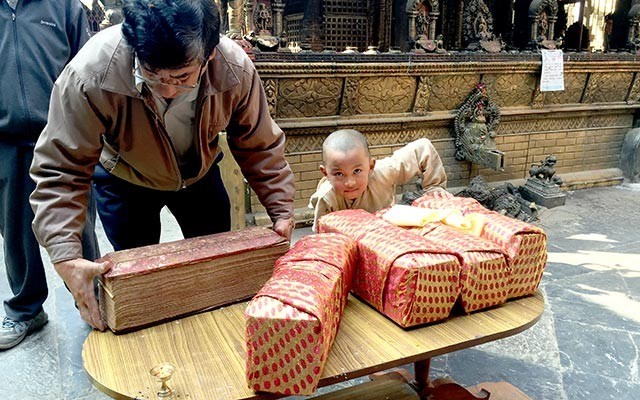In Kathmandu to trek to Everest Base Camp, we're preparing our kit at Dwarka House, a genuine Newari dwelling of handmade brick centered on an alleyway courtyard off a side street. Our host is Prakash, a jocular fellow who'd undergone open-heart surgery for an aortic valve replacement at age 28. Over the next decade he'd led an insipid life with a litany of restrictive dos and don'ts — until he discovered mountain biking. Adopting a strict riding regimen, he eventually won Kathmandu's Mountain Bike Madness Race and made daring overland journeys from Muktinath to Pokhara, and Lhasa to Kathmandu. Today, age 51, he does what he can while running his now-popular homestay — the place he grew up in, where hints of that life are seen in everything from an indoor well where the family still pumps water, to his father's black-and-white photojournalism mounted and hung with other artifacts.
This part of town — old Patan — was hit hard by the April 2015 earthquake that killed 9,000 and injured 23,000, and many leaning buildings were now propped up by 2x4s affixed to the ground with rebar. Dwarka House was advertised on Air B&B as "safe" with good reason: when he'd restored the place years ago, Prakash had structurally reinforced everything with iron beams, including the many Escheresque staircases. This turns out to be a good thing when we're pouring over a map at a table on the fourth floor and a magnitude 5.3 earthquake shakes us for a full 30 seconds. Ami, Prakash's daughter, is terrified, and outside people run into the streets. It's been months since an aftershock of any kind, and so this trembler is both surprise and reminder that preparations for the next one need to continue.
Patan is a great place to stroll, and we find a festival devoted to crows, dogs and cows just winding up. Colourful garlands and food offerings are everywhere — the latter keeping the street dogs and pigeons happy. Flower vendors string marigolds among Mandela painters near the Golden Temple, and it's only a few minutes' walk to Patan Durbar Square and one of the best museums in all of Asia. Here, however, you can also see the quake's true ravages: only a few historic temples remain intact while their neighbours are rubble and dust. Other changes since my last visit in 1999 are palpable: more aggressive begging and price-gouging tourist traps — born of a collision of increased visitation, poverty, and ongoing crises. Fabled Thamel district is still Thamel only the bad parts have grown worse — larcenous pedi-cab and souvenir hawkers, dozens of questionable guiding services, a glut of WiFi-enabled coffee shops (like "Starbeans") catering to Westerners, and more North Face and other gear knock-offs than you can believe. That being said, bigger things are affecting the country than China's criminal, state-sanctioned counterfeit industry. Unhappy with Nepal's new constitution, regional bully India has purposefully created a fuel shortage that's now six months old. Lineups for petrol last up to two weeks, and we witness morose scenes of people in/on cars, trucks, and motorbikes, waiting, sleeping, waiting because they can't afford black-market gasoline. The same goes for heating and cooking fuels, whose lineups are even sadder given the indigence and descending winter. Effects are also manifold for visitors: taxi, bus and air fares have quadrupled; food and commodity prices are skyrocketing; international air carriers that can't refuel in Kathmandu have suspended or re-jigged routes, and many internal flights are cancelled, including to Lukla — world's most dangerous airport, gateway to Everest, and our destination next day.
As it turns out, the 30-minute flight to Lukla in the heart of the Himalaya at 6 a.m. is only quasi-harrowing in the calm morning air, though we can see how it's dicey in bad weather and why the airport has its deadly reputation. Slamming into the 500-metre-long runaway at 2,800 mph is an experience because you see it coming through the turboprop's flight deck — the tarmac is angled uphill and so appears as a vertical stripe on the mountainside. Flights (once 50 per day) pile in early before thermals start to build, every five minutes in a daily shuffle of trekkers and guides and porters and more trekkers. The fuel-crisis flight backlog is reflected in the eyes of those who've been stuck here for a while when we land — they try to barge onto our plane before we're even off, their baggage thrown in as fast as ours is pulled out.
It all seems a little crazier than it should be, but before we know it our packs are on our backs and our little group — Asta, myself, guide Nowa and porter Norbu Sherpa — have strolled past the cobblestoned perimeter of this storied town, spun a few mani prayer wheels along the way for good luck, and are on the trail to Everest.
Next time—Finding Everest III: To Sagarmatha.




